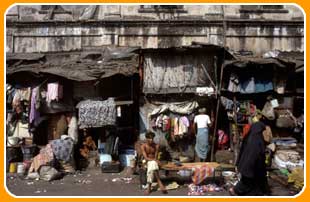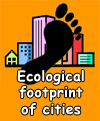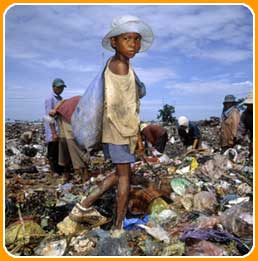Out of control?
Providing enough food, water, shelter, energy and security is an enormous challenge in any city. When these basic needs are in short supply prices go up, and it is the poorest communities that suffer the most.
| Rents in downtown Mumbai, India are some of the highest in the world. Meanwhile, half the people that live in Mumbai live in shanty towns known as chawls, or on the streets. By 2010, chawls could be home for 90% of Mumbai's residents. |

© Jean-Léo Dugast/Panos Pictures |
According to the United Nations, there are now nearly a billion people that live in slums, and this could double in the next thirty years. Visit www.unchs.org/istanbul+5/statereport.htm to download parts of the UN's 'State of the World's Cities' report.
Big Foot
Many cities live beyond their means and their ecological footprint is enormous. Cities only cover two per cent of the earth's surface, but they use 75% of the world's resources. |
 |
Modern city living wastes money too. As people take time off work because of illnesses caused by pollution, and traffic jams hold up trade and deliveries, businesses are losing money. Money is thrown away as resources like water and energy are used inefficiently, and waste disposal is becoming more expensive as space for waste runs out.
Concerned for the future, the UN's Sustainable Cities Programme is giving a major re-think to how cities should be managed. The programme offers practical advice to over forty cities on how to become more self-sufficient, and how to improve the quality of life for everybody. Visit www.unchs.org/programmes/sustainablecities/cities.asp to find out more. The Mega Cities project makes the most of technology between today's global network of cities. By sharing good ideas on how cities can develop, people can help and learn from each other.
What makes a sustainable city?
Click on the letters to find out.
Click on the icons to read about two cities of the future. For each one, think about:
In what ways is the city sustainable?
In what ways is the city not sustainable?
What improvements would make the city more sustainable?
Who has made the decisions about planning the city?
Who should decide what the city of the future should be like?
Which city is the most likely city of the future?
Which city would you prefer to live in?

© Mikkel Ostergaard/Panos Pictures |
The best ideas for managing a city often come from local communities. After all, they are more likely to know best what the people in the neighbourhood need, and how to make the most of local resources. In Phnom Penh, the capital city of Cambodia, recycling and re-use amongst poorer communities is standard practice. In cities like Phnom Penh, the throwaway rate is about ten times lower than in cities in the rich world. |
- Visit www.livingstreets.org.uk to find out about a campaign to reconnect and revitalise neighbourhoods in UK cities.
- Find out about Malaysia's plans to develop the world's first sustainable cyber city at www.mdc.com.my
- For examples of success stories in sustainable cities visit http://bestpractices.org/bpbriefs/Urban_Development.html
- Visit www.globaleye.org.uk/secondary_summer2002/eyeon/improve.html to find out about projects that focus on community self-help in the favelas of Rio de Janeiro, Brazil.
- Visit www.lsx.org.uk to find out about attempts to make London more sustainable.





